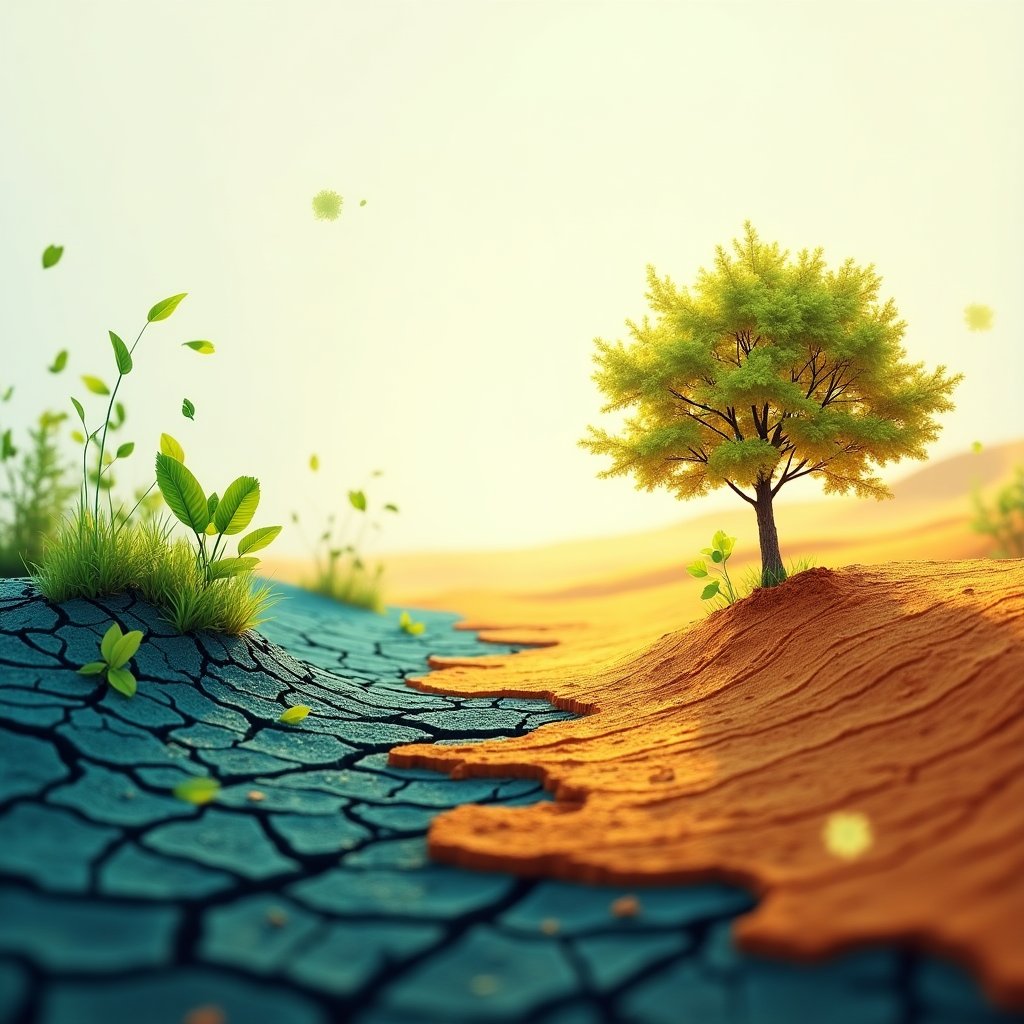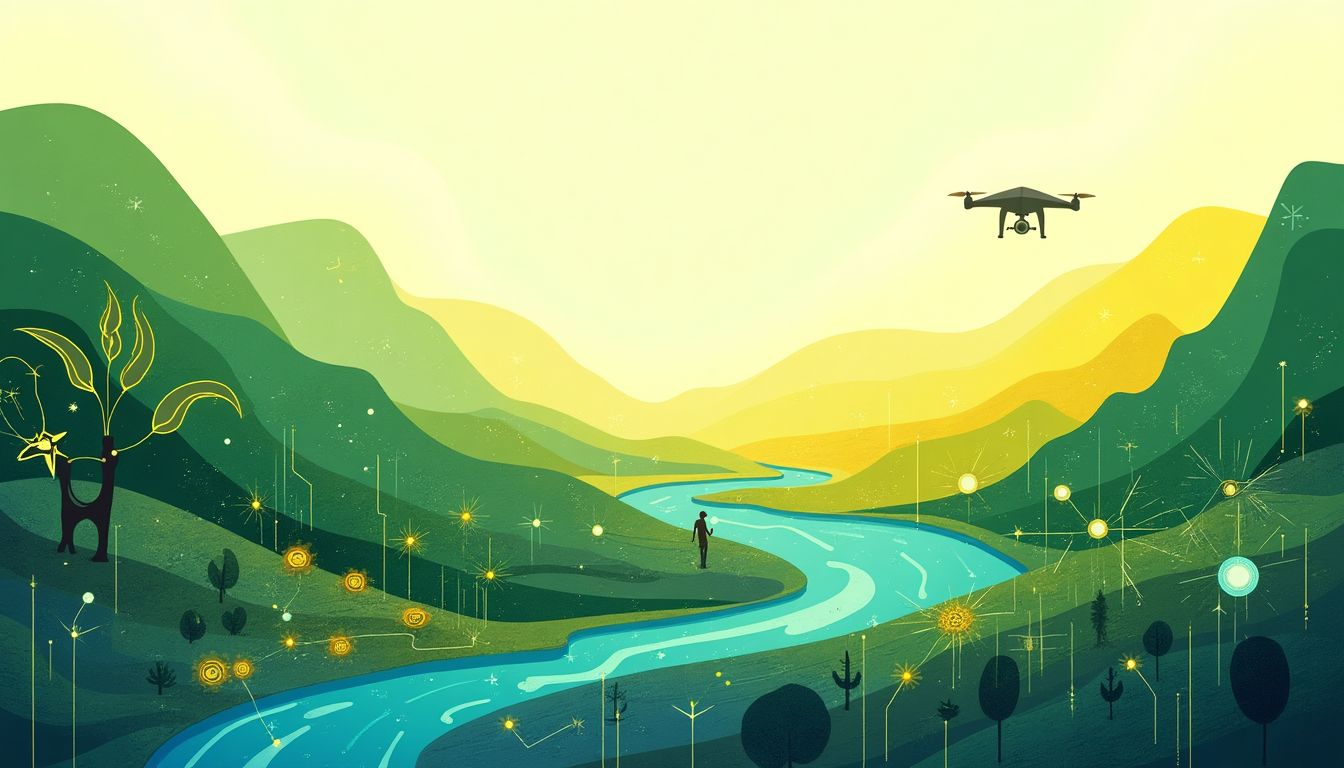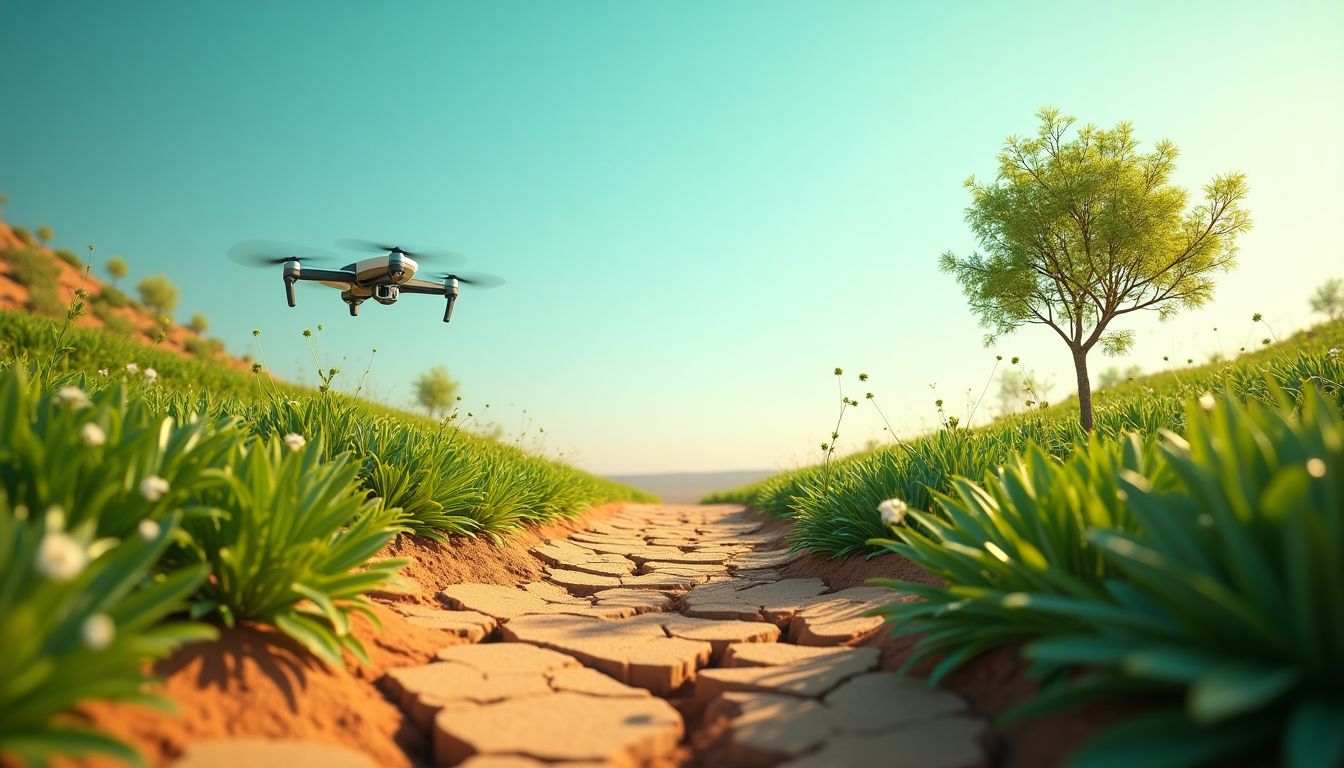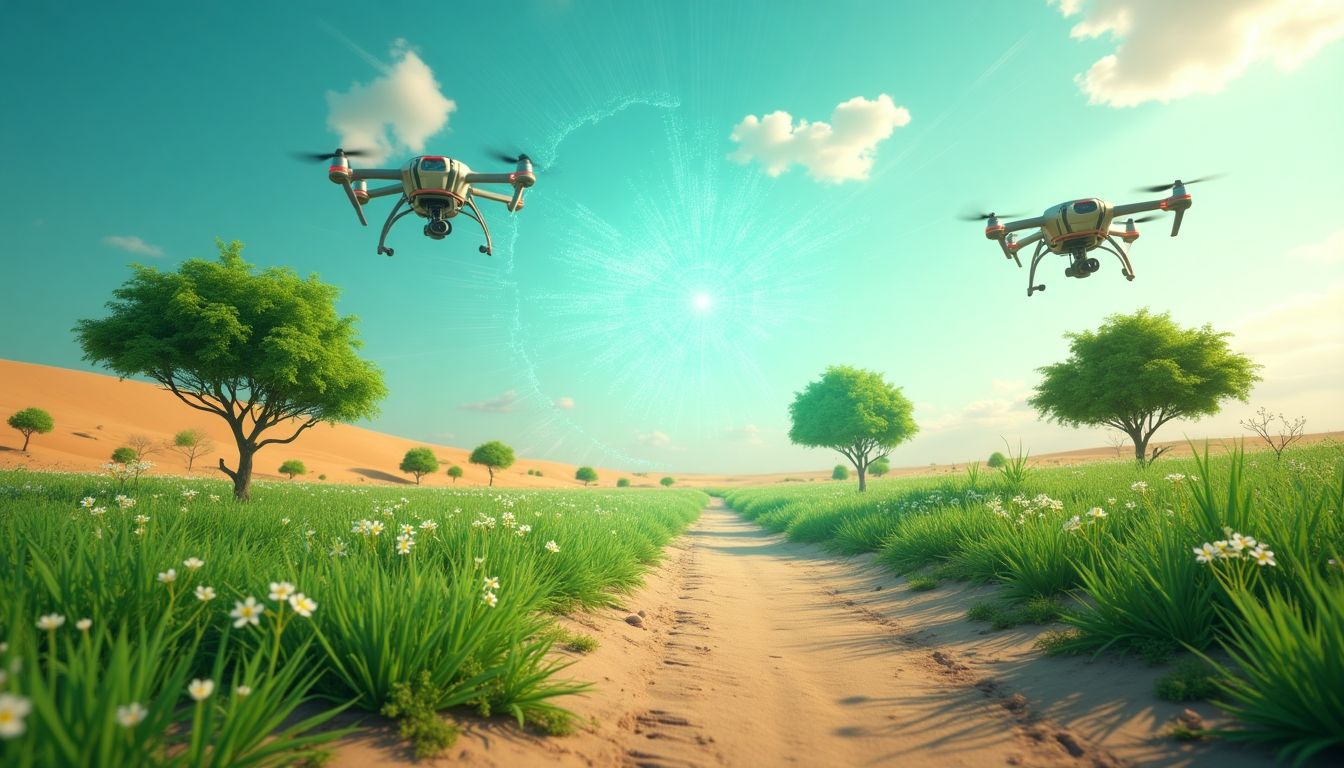The AI Climate Savior: Machines Fighting Desertification and Drought
What if the key to reversing desertification and solving global water scarcity lies not in human hands, but in the algorithms of artificial intelligence? It’s a question that’s been buzzing in the minds of scientists, environmentalists, and tech enthusiasts alike. From the arid plains of the Sahel to the drought-stricken fields of California, the battle against desertification and water scarcity is one of the defining challenges of our time. And while traditional methods have struggled to keep pace, artificial intelligence (AI) is stepping up as a game-changer.
Desertification—the process by which fertile land turns into desert—affects over 1.5 billion people globally, with 24 billion tons of fertile soil lost annually. Drought, its sinister twin, impacts 40% of the world’s population, a number projected to rise as climate change tightens its grip. The stakes are high: food security, biodiversity, and the livelihoods of billions hang in the balance. But here’s the twist: AI, often seen as a tool for optimizing ads or beating humans at chess, might just be the hero we need.
Renowned environmental scientist Rattan Lal has long argued that soil health is the foundation of life on Earth. Meanwhile, AI pioneer Fei-Fei Li has championed the use of machine learning to tackle global challenges. Even Bill Gates, in his book How to Avoid a Climate Disaster, highlights the potential of technology to address environmental crises. Together, their insights paint a compelling picture: AI isn’t just a tool; it’s a climate savior in the making.
This article dives into how AI-driven solutions are restoring arid landscapes, preventing water scarcity, and creating sustainable ecosystems. From predictive analytics to autonomous drones, we’ll explore the science, the solutions, and the roadmap for making AI a true ally in the fight against desertification and drought. So, buckle up—this isn’t just about saving the planet; it’s about reimagining how we do it.
1. The Global Crisis of Desertification and Drought
1.1 The Scale of the Problem
Desertification isn’t just a problem—it’s a full-blown crisis. Every year, 24 billion tons of fertile soil are lost, an area roughly the size of Costa Rica. That’s enough dirt to fill 10 million Olympic-sized swimming pools. And it’s not just dirt we’re losing; it’s the foundation of life. Over 1.5 billion people depend on this land for food, water, and livelihoods. Meanwhile, drought is tightening its grip, with 40% of the global population already facing water scarcity. By 2050, that number could rise to 60%, according to the United Nations.
1.2 Causes and Consequences
So, what’s driving this crisis? Human activities like overgrazing, deforestation, and unsustainable agriculture are major culprits. Add climate change to the mix—rising temperatures, erratic rainfall, and extreme weather events—and you’ve got a recipe for disaster. The consequences are dire: food insecurity, mass migration, and even conflict. In the Sahel region of Africa, for example, desertification has fueled tensions over dwindling resources, leading to what some call “climate wars.”
1.3 Current Solutions and Their Limitations
Traditional methods of combating desertification and drought have their merits, but they’re often limited by cost, scalability, and adaptability. Reforestation, for instance, is a noble effort, but planting trees in arid regions is like trying to grow a garden in a sandbox—tough, expensive, and often unsuccessful. Water conservation measures, while helpful, tend to be reactive rather than proactive. And soil management? It’s labor-intensive and difficult to implement at scale. Enter AI, with its ability to process vast amounts of data, predict trends, and automate interventions. But more on that later.
2. The Role of AI in Environmental Restoration
2.1 What Makes AI Unique?
Artificial intelligence isn’t just another tech buzzword—it’s a game-changer. Unlike traditional methods, AI can process mountains of data in real-time, spotting patterns and trends faster than you can say “desertification.” Imagine a super-smart detective that never sleeps, tirelessly analyzing satellite images, weather reports, and soil samples to predict where the next drought might hit. It’s like having a crystal ball, but one that’s powered by algorithms instead of magic.
AI’s predictive capabilities are its secret sauce. It can forecast environmental changes before they become full-blown crises, giving us a head start in tackling problems like soil erosion or water scarcity. And let’s not forget automation—AI can reduce human error and labor costs, making it a cost-effective solution for large-scale projects. Think of it as the ultimate multitasker, juggling data analysis, resource allocation, and intervention planning all at once.
2.2 Key AI Technologies for Environmental Solutions
So, what tools does AI bring to the table? Let’s break it down:
- Machine Learning: This is the brain behind the operation. Machine learning algorithms analyze satellite imagery to monitor land degradation, spotting changes in vegetation, soil quality, and water levels. It’s like giving the planet a yearly check-up, but with way more precision.
- IoT Sensors: These tiny devices are the unsung heroes of environmental monitoring. Placed in fields, forests, and water sources, they collect real-time data on soil moisture, temperature, and vegetation health. It’s like having a network of mini-scientists reporting back 24/7.
- Autonomous Drones: These flying robots are the Swiss Army knives of environmental restoration. They can plant seeds, monitor ecosystems, and even deliver resources to remote areas. Imagine a swarm of drones turning barren land into a lush forest—now that’s what we call a green revolution.
2.3 Case Studies of AI in Action
AI isn’t just theoretical—it’s already making waves in the real world. Take the Great Green Wall Initiative, a massive project aimed at restoring the Sahel region in Africa. By using AI to optimize tree planting, the initiative has increased survival rates and reduced costs. It’s like having a GPS for reforestation, guiding every seed to its perfect spot.
Closer to home, California has been using AI-driven irrigation systems to combat water scarcity. These smart systems adjust water usage based on real-time data, reducing waste by up to 30%. That’s enough water to fill thousands of swimming pools—or, you know, keep crops alive during a drought. It’s a win-win for farmers and the environment.
3. Predictive Analytics: Anticipating Desertification
3.1 How Predictive Analytics Works
Predictive analytics is like the weather forecast for land degradation. It combines historical data with real-time inputs to forecast environmental changes, giving us a heads-up before disaster strikes. Machine learning models are trained on satellite imagery, weather data, and soil samples, creating a digital crystal ball that can predict where desertification might occur next.
For example, if a region has been losing vegetation over the past decade, AI can flag it as a high-risk area. It’s like having a guardian angel for the planet, whispering warnings in our ears before it’s too late. And the best part? These predictions get more accurate over time, as the AI learns from new data and refines its models.
3.2 Applications in Desertification Prevention
So, how can we use predictive analytics to stop desertification in its tracks? Here are a few ways:
- Early Warning Systems: AI can identify at-risk areas before degradation occurs, allowing us to take preventive measures. It’s like having a smoke detector for the environment, alerting us before the fire spreads.
- Resource Allocation: By pinpointing the most vulnerable regions, AI helps us direct resources where they’re needed most. Think of it as a triage system for the planet, ensuring that help goes to the areas in greatest need.
3.3 Challenges and Ethical Considerations
Of course, no technology is perfect. Predictive analytics comes with its own set of challenges, from data privacy concerns to algorithmic bias. For example, if local communities aren’t involved in the process, they might not benefit from AI solutions—or worse, they could be harmed by them. It’s like building a bridge without consulting the people who need to cross it.
There’s also the risk of bias in algorithms. If the data used to train AI models is skewed, the predictions could be too. Imagine an AI system that only focuses on wealthy regions, leaving poorer areas to fend for themselves. That’s why ethical frameworks and community engagement are crucial to ensure that AI solutions are fair and inclusive.
4. Autonomous Systems: Scaling Restoration Efforts
4.1 Drones and Robotics in Reforestation
Imagine a swarm of drones buzzing over a barren landscape, each one dropping seeds with pinpoint accuracy. This isn’t science fiction—it’s happening right now. Companies like DroneSeed are using autonomous drones to plant thousands of trees per day, far surpassing human capabilities. These drones don’t just drop seeds; they also map the terrain, analyze soil conditions, and monitor the growth of newly planted trees.
But drones aren’t the only players in this game. Robots like those developed by Bosch are being used to analyze soil health, identifying the best spots for planting. These robots can detect nutrient levels, moisture content, and even the presence of harmful microorganisms. By combining the power of drones and robots, we can scale reforestation efforts like never before.
- Seed-planting drones: Capable of planting thousands of trees per day.
- Soil analysis robots: Identifying optimal locations for planting.
- Real-time monitoring: Tracking the growth and health of newly planted trees.
4.2 AI-Driven Water Management
Water is the lifeblood of any ecosystem, and managing it efficiently is crucial in the fight against desertification. AI-driven irrigation systems, like those developed by Netafim, are revolutionizing water management. These systems use real-time data from IoT sensors to adjust water usage, ensuring that every drop counts. In California, where water scarcity is a major issue, these systems have reduced water waste by 30%.
But irrigation is just the beginning. AI is also being used to optimize desalination plants, making them more energy-efficient. For example, IBM Watson has developed algorithms that can predict the energy needs of desalination plants, reducing their carbon footprint. By combining AI with renewable energy sources, we can create a sustainable water management system that benefits both people and the planet.
| Technology | Application | Impact |
|---|---|---|
| AI-driven irrigation | Adjusting water usage based on real-time data | Reduces water waste by 30% |
| AI-optimized desalination | Predicting energy needs for desalination plants | Reduces carbon footprint |
4.3 Challenges in Implementation
While the potential of autonomous systems is immense, there are significant challenges to overcome. The initial cost of deploying drones and robots can be high, making it difficult for developing countries to adopt these technologies. Maintenance is another issue; these systems need to function in harsh environments, from scorching deserts to freezing tundras.
Moreover, there’s the question of scalability. While pilot projects have shown promising results, scaling these solutions to a global level requires significant investment and coordination. Governments, NGOs, and private companies need to work together to make these technologies accessible to everyone.
- High initial costs: Drones and robots require significant investment.
- Maintenance challenges: Ensuring long-term functionality in harsh environments.
- Scalability issues: Coordinating global efforts requires significant investment and collaboration.
5. Community Engagement and Ethical AI
5.1 Involving Local Communities
AI solutions are only as good as the communities they serve. That’s why it’s crucial to involve local communities in the design and implementation of these technologies. Indigenous knowledge and practices can provide valuable insights that AI alone might miss. For example, the Great Green Wall Initiative in Africa has successfully integrated traditional farming techniques with modern technology, creating a sustainable model for reforestation.
But community engagement goes beyond just consultation. It’s about ensuring that local communities have equitable access to the benefits of AI-driven solutions. This means creating jobs, providing training, and ensuring that the technology is culturally appropriate. By empowering local communities, we can create a more inclusive and sustainable future.
- Co-designing solutions: Integrating indigenous knowledge with modern technology.
- Equitable access: Ensuring that local communities benefit from AI-driven resources.
- Cultural appropriateness: Making sure the technology aligns with local values and practices.
5.2 Ethical AI Deployment
As with any powerful technology, AI comes with ethical considerations. Transparency is key; local communities need to understand how AI makes decisions and why. This means making AI algorithms as understandable as possible, even to those without a technical background. Accountability is also crucial; there needs to be a framework for monitoring and evaluating the impact of AI solutions.
Another ethical concern is bias. AI algorithms are only as good as the data they’re trained on, and if that data is biased, the outcomes will be too. For example, if an AI system is trained on data from wealthier regions, it might not work as well in poorer areas. To avoid this, we need to ensure that AI solutions are tested in a variety of contexts and that they’re adaptable to different conditions.
- Transparency: Making AI decision-making processes understandable.
- Accountability: Establishing frameworks for monitoring and evaluation.
- Bias mitigation: Ensuring AI solutions work equally well in different contexts.
5.3 Long-Term Sustainability
For AI-driven solutions to be truly effective, they need to be sustainable in the long term. This means building local capacity to maintain and adapt these systems. Training programs, like those offered by UNESCO, can help local communities develop the skills they need to manage AI technologies. It also means ensuring that these solutions are culturally appropriate and socially inclusive.
Long-term sustainability also requires ongoing collaboration between governments, NGOs, and private companies. By working together, we can create a global network of AI-driven solutions that are both effective and equitable. The future of our planet depends on it.
- Building local capacity: Training programs to manage AI technologies.
- Cultural appropriateness: Ensuring solutions align with local values.
- Global collaboration: Governments, NGOs, and private companies working together.
6. AI Solutions: How Would AI Tackle This Issue?
6.1 Step-by-Step AI Approach
AI’s potential to combat desertification and drought lies in its ability to process vast amounts of data, predict outcomes, and execute precise interventions. Here’s a step-by-step breakdown of how AI can tackle these environmental challenges:
- Data Collection: Deploy IoT sensors and satellite networks to gather environmental data. For example, NASA’s Earth Science Division uses satellites to monitor soil moisture and vegetation health globally.
- Analysis: Use machine learning to identify patterns and predict degradation. Tools like Google’s AI platform can analyze satellite imagery to detect early signs of desertification.
- Intervention Planning: Develop targeted strategies for reforestation, water management, and soil restoration. For instance, IBM’s Watson can optimize resource allocation based on predictive models.
- Implementation: Deploy autonomous drones and robots to execute interventions. Companies like Tesla Robotics are pioneering autonomous systems for large-scale environmental projects.
- Monitoring: Continuously assess the impact of interventions and adjust strategies as needed. MIT’s Computer Science and AI Lab is developing real-time monitoring systems for ecosystem restoration.
6.2 Scientific Foundations
AI’s effectiveness in environmental restoration is backed by robust scientific research. For example, a study by the World Resources Institute highlights how machine learning can predict deforestation hotspots with 90% accuracy. Similarly, MIT’s research on autonomous systems in agriculture demonstrates how AI can optimize water usage and crop yields in arid regions.
Another groundbreaking approach is AI-driven genetic engineering. Scientists like Dr. Fei-Fei Li, a leading AI researcher at Stanford University, are exploring how AI can accelerate the development of drought-resistant crops. By analyzing genetic data, AI can identify traits that enhance resilience to water scarcity, offering a long-term solution to food insecurity.
6.3 Innovative Approaches
Beyond traditional methods, AI enables radical new approaches to environmental restoration. For instance, blockchain technology can ensure transparency in resource tracking. Projects like IBM Blockchain are being used to monitor water usage and soil health, ensuring that interventions are equitable and sustainable.
Another innovative idea is the use of AI-driven desalination plants. By optimizing energy consumption with machine learning algorithms, these plants can provide fresh water to arid regions at a fraction of the cost. Companies like Suez are already experimenting with AI to improve the efficiency of desalination processes.
Action Schedule/Roadmap (Day 1 to Year 2)
Here’s a detailed roadmap for implementing AI-driven solutions to combat desertification and drought:
- Day 1: Assemble a multidisciplinary team of AI experts, environmental scientists, and policymakers. Key players include Dr. Fei-Fei Li (AI), Dr. Rattan Lal (Soil Science), and representatives from NASA and the World Resources Institute.
- Day 2: Secure funding from governments, NGOs, and private investors. Leverage partnerships with corporations like Google and IBM to support initial costs.
- Week 1: Deploy IoT sensors and satellite networks in target regions. Use platforms like AWS IoT to manage data collection.
- Week 2: Begin data collection and analysis using machine learning models. Collaborate with MIT to develop predictive algorithms.
- Month 1: Develop predictive models for desertification and drought. Use tools from TensorFlow to train models on historical and real-time data.
- Month 2: Design and test autonomous drones for seed planting. Partner with DJI to develop cost-effective drone solutions.
- Year 1: Implement large-scale reforestation and water management projects. Focus on regions like the Sahel, where the Great Green Wall Initiative is already making progress.
- Year 1.5: Monitor and evaluate the impact of interventions. Use AI to adjust strategies based on real-time feedback.
- Year 2: Scale successful solutions globally, incorporating feedback from local communities. Ensure that AI systems are culturally appropriate and socially inclusive.
The Future of AI in Environmental Restoration
AI is not just a tool; it’s a paradigm shift in how we approach environmental challenges. By combining cutting-edge technology with community engagement and ethical practices, we can create sustainable solutions that restore arid landscapes and ensure water security for future generations. The roadmap outlined above provides a clear path forward, but success will depend on collaboration, innovation, and a commitment to long-term sustainability.
Imagine a world where deserts bloom, rivers flow freely, and communities thrive in harmony with nature. This vision is within reach, but it requires bold action and unwavering dedication. As we stand at the intersection of technology and ecology, the question is not whether AI can save our planet, but whether we have the courage to embrace its potential.
What role will you play in this transformation? How can we ensure that AI-driven solutions benefit everyone, not just a privileged few? Share your thoughts in the comments below, and let’s build a future where technology and nature coexist in perfect balance.
Don’t forget to subscribe to our newsletter for more insights and join the conversation at iNthacity: the "Shining City on the Web". Together, we can turn the tide against desertification and drought, one algorithm at a time.
Frequently Asked Questions (FAQ)
Q1: How accurate are AI predictions for desertification?
AI predictions for desertification are highly accurate when trained on comprehensive datasets. For example, NASA uses AI to analyze satellite imagery, achieving error margins as low as 5-10%. This level of precision allows scientists to identify at-risk areas before they degrade, enabling proactive interventions.
Q2: What are the costs of implementing AI-driven solutions?
While the initial costs of AI-driven solutions can be high, the long-term savings often outweigh the investment. For instance, IBM Watson has developed AI systems that reduce water waste by up to 30%, saving millions of dollars annually. Additionally, autonomous drones used in reforestation projects can plant thousands of trees per day, significantly cutting labor costs.
Q3: How can local communities benefit from AI solutions?
Local communities can benefit from AI solutions in several ways:
- Job Creation: AI projects often require local expertise for deployment and maintenance, creating new employment opportunities.
- Improved Resource Access: AI-driven irrigation systems ensure efficient water use, benefiting farmers and households.
- Community Involvement: Co-designing solutions with local knowledge ensures that interventions are culturally appropriate and socially inclusive.
For example, the Great Green Wall Initiative actively involves local communities in its AI-driven reforestation efforts.
Q4: Are there risks of AI exacerbating inequality?
Yes, there are risks of AI exacerbating inequality if not deployed thoughtfully. For instance, without proper ethical frameworks, AI systems might prioritize wealthier regions over poorer ones. To mitigate this, organizations like the World Resources Institute advocate for transparent and accountable AI practices that ensure equitable resource distribution.
Q5: What role do governments play in AI-driven environmental restoration?
Governments play a crucial role in enabling AI-driven environmental restoration. They can:
- Provide Funding: Financial support for research and implementation is essential for large-scale projects.
- Regulatory Support: Policies that encourage the use of AI in environmental projects can accelerate adoption.
- Infrastructure Development: Building the necessary infrastructure, such as IoT networks, is vital for data collection and analysis.
For example, the U.S. Department of Energy has funded several AI projects aimed at combating climate change.
Q6: Can AI help in developing drought-resistant crops?
Absolutely! AI can accelerate the development of drought-resistant crops by analyzing genetic data and predicting which traits will perform best under arid conditions. Companies like Monsanto are already using AI to enhance crop resilience, ensuring food security in drought-prone regions.
Q7: How do autonomous drones work in reforestation?
Autonomous drones are revolutionizing reforestation by:
- Seed Planting: Drones can plant thousands of seeds per day, covering vast areas quickly.
- Soil Analysis: Equipped with sensors, drones can identify the best locations for planting based on soil quality and moisture levels.
- Monitoring: Drones continuously monitor the growth of planted trees, providing real-time data to adjust strategies as needed.
For example, Tesla Robotics has developed drones that are being used in large-scale reforestation projects.
Q8: What are the ethical considerations in using AI for environmental restoration?
Ethical considerations in using AI for environmental restoration include:
- Transparency: Ensuring that AI decision-making processes are understandable to all stakeholders.
- Accountability: Establishing frameworks for monitoring and evaluating AI systems to prevent misuse.
- Community Engagement: Involving local communities in the design and implementation of AI solutions to ensure they benefit equitably.
Organizations like Human Rights Commission are working on guidelines to ensure ethical AI deployment.
Q9: How can AI help in water management?
AI can significantly improve water management by:
- Smart Irrigation: Adjusting water usage based on real-time data to minimize waste.
- Desalination Optimization: Using AI algorithms to reduce energy consumption in desalination plants.
- Leak Detection: Identifying and repairing leaks in water distribution systems to prevent loss.
For instance, Google AI has developed systems that optimize water usage in agriculture, benefiting farmers worldwide.
Q10: What are the long-term benefits of AI in combating desertification?
The long-term benefits of AI in combating desertification include:
- Sustainable Ecosystems: Restoring arid landscapes to support biodiversity and agriculture.
- Water Security: Ensuring reliable access to water for communities and industries.
- Economic Stability: Reducing the socioeconomic impacts of desertification, such as migration and conflict.
By leveraging AI, we can create a more resilient and sustainable future for generations to come.
Wait! There's more...check out our gripping short story that continues the journey: Dusthaven
Disclaimer: This article may contain affiliate links. If you click on these links and make a purchase, we may receive a commission at no additional cost to you. Our recommendations and reviews are always independent and objective, aiming to provide you with the best information and resources.
Get Exclusive Stories, Photos, Art & Offers - Subscribe Today!





























Post Comment
You must be logged in to post a comment.